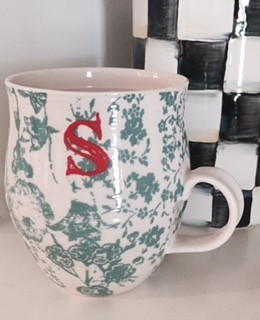Years ago, my girlfriend invited me to take a class with some of her mom friends. It was a wonderful way to connect with other moms and meet new people. The only prerequisite was to bring my favorite coffee cup.

Most of my coffee cups were plain. I wasn’t very excited about my choices, but I had some time to find one I liked. It must have been around a holiday because shortly after that my cousin gifted me one. It was unique and quirky, and I loved it. Covered in a greenish-blue sketch of flowers, it had an off-center and crooked red “S” for my name. It was small, you could see the pottery rings inside, and the handle was a bit off center. It was perfectly imperfect. I had found my cup.
I showed up for the first class with my coffee cup in hand. After small talk and introductions, the leader asked us to spend time analyzing and describing our cups. One woman said she used the same cup every morning because, although it was cracked, she loved the way it felt in her hands. Another woman said she liked the colors of her cup, and it was deep enough for a big cup of coffee. Another woman said she just grabbed one off the shelf. She did not think too much about what it looked like; she only cared about the drink inside. Another woman said she liked nothing about her coffee cup. It was ugly and small, and she didn’t drink coffee anyway. And then it was my turn. I explained that I usually drank out of a plain white coffee cup, but I had just received this cup as a gift, and I loved it. It was unique, it was different, it wasn’t perfect, but it made me smile.
As the class progressed, it became clear that the coffee cup was a representation of our bodies. Our cup might be cracked, our cup might be faded, or our cup might be a funny shape, but it didn’t matter. It represented our imperfections, our journey, our uniqueness. And yet for years I had used a plain white coffee cup. It was boring and safe, and I was tired of it. My new cup was much more like the person I wanted to be. It was whimsical, colorful, and definitely not perfect. It was time to love and enjoy my cup with all its imperfections and quirkiness.
Life continued and my class became a distant memory until a few years later. Every morning I make my coffee the exact same way; I brew it, pour it, squeeze honey into it, stir it, and fill it with ice. If I have not finished my cup of coffee by the time I drive my kids to school, I pour it into another cup so I can take it in the car.
On this particular day, I chose to pour my coffee into a red Solo Cup. I drove my daughter to school, parked my car, grabbed my coffee, and walked my daughter inside. I smiled and waved at teachers, friends, and students while holding and sipping my coffee-filled red Solo Cup. I met up with a friend in the parking lot, and she quickly quipped, “How’s that early morning beer?” She laughed, and I looked at my cup in amazement. It never dawned on me that people might assume my cup was filled with beer.
As I drove home, I went back to the coffee cup metaphor from my class years before. If our cup represents our body, what we put inside our cup represents who we truly are: our insecurities and struggles, our beliefs and values, what we love. But just like my red Solo Cup, we often make assumptions about other people based on what we see or what we hear. We rarely take the time to find out if our assumptions are true. Almost instantly I began wondering how my coffee cup metaphor was affecting my role as a mom. Was I looking inside my children’s cups or was I assuming I knew what was inside?
Then it dawned on me; the best way to look inside my children’s cups was to go grab a metaphorical cup of coffee with them. No, I am not advocating for young coffee drinkers, but I am advocating for what having a cup of coffee with someone represents—time and connection. It is the only way we can know what is truly inside our children’s cups.
Whether it is through play, at dinner, on a walk around the neighborhood, or during tuck-in, schedule time each day for one-on-one, technology-free time to connect with your child. Listen to them, observe them, validate them, and enjoy them.
I think it is fair to say that our children and our world need less assuming and more connecting. By connecting more, we will assume less. Grab yourself a cup, fill it with what you love, and go connect. Who knew that a cup of coffee could teach so many life lessons!
This post comes from the TODAY Parenting Team community, where all members are welcome to post and discuss parenting solutions. Learn more and join us! Because we're all in this together.
